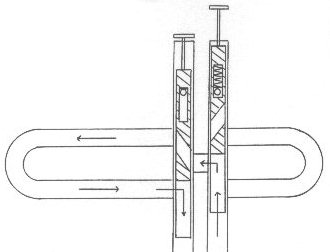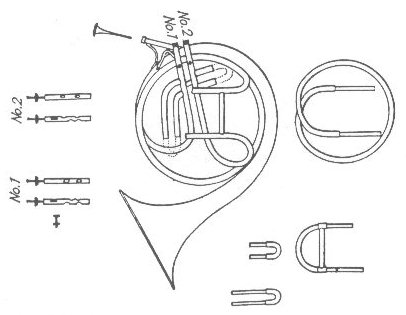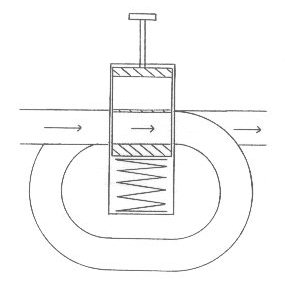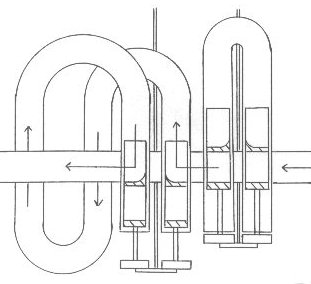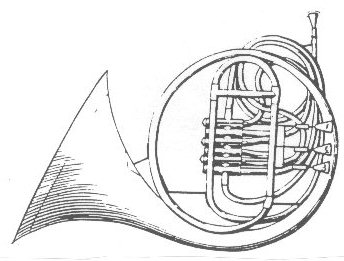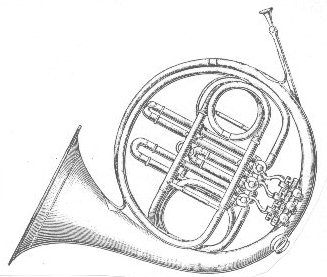Early Valve DesignsThe six most important types of early valves. John EricsonThis article is based on my dissertation, an expansion of materials published in The Horn Call Annual 4 (1992). As noted in the article "Why Was the Valve Invented," the valve was first applied to the horn in 1814 by hornist Heinrich Stölzel (1777-1844). The joint patent of the valve in 1818 by Heinrich Stölzel and Friedrich Blühmel (fl. 1808-before 1845, a miner who played trumpet and horn in a band in Waldenburg [Heyde, part I, 20--the older literature frequently describes Blühmel as an oboe player, which is in error]), marked the beginning of a burst of activity by inventors and manufacturers wanting to exploit this new technology. Many different types of valves came out in this period, but six designs stand out as being the most successful. The first successful valve design was the Stölzel valve, named after its inventor. The Stölzel valve was, worldwide, the single most popular type of valve before 1850 [Bate], especially in France. Its design was fairly simple to construct (the air passages in the piston were often simply made of cork, for example) and overall it provided satisfactory results. See figures 1 and 2. Figure 1. Stölzel valves. Figure 2. Horn with Stölzel valves. This slender piston-type valve had some inherent acoustic problems. For example, the bore of the instrument, disrupted at the 90-degree bend in the windway at the bottom of the valve casing, was then further disrupted in the middle air passage of the valve. In addition, as the air entered the bottom of at least one piston, the valves could push air back at the performer when depressed, creating undesirable back pressure. Valves of this design were also difficult to disassemble. The valve described in the original 1818 patent of Stölzel and Blühmel is known as the box valve. See figures 3 and 4. Blühmel developed this design in 1817/18 [Heyde, ibid, 22]. Acoustically, this design is theoretically far superior to the Stölzel valve as it avoids sharp bends in the windway, disruptions in the bore, and potential back pressure, but due to its square shape the box valve was undoubtedly difficult to construct and maintain. The box valve was probably applied to only a few horns. Figure 3. Box valve. Figure 4. Detachable horn valve section with box valves. In Germany, the first important early design was the Vienna valve, a double-piston valve related to the Stölzel valve in design but avoiding some of its problems. See figures 5 and 6. This valve design, patented [see endnote] in 1823 by Viennese instrument maker Joseph Riedl (d. 1840) and hornist Josef Kail (1795-1871), had actually been produced as early as 1819 by instrument maker C. F. Sattler (1778-1842) of Leipzig and possibly earlier by Stölzel and Blühmel [Dahlqvist, 111, 114, and 123. Leopold Ulhmann of Vienna also held an 1830 patent on an improved Vienna valve]. The use of two pistons for each valve loop made for a more consistent bore and eliminated the potential problem of back pressure found in the single-piston Stölzel valve. However, when a Vienna valve is depressed it introduces two sharp 90-degree angles into the windway, and also introduces two sudden constrictions of approximately 8% in the bore, neither of which assist in the response of the instrument [Merewether, 31]. It should be noted that the Stölzel valve shares these same defects of design. German players favored the Vienna valve until the 1850s [Carse, 222], while Austrian players continued to used it throughout the nineteenth century and beyond. Figure 5. Vienna Valves. Figure 6. Horn with Vienna Valves. Another early type of valve seen in Germany was the Berlin valve, initially developed by 1827 by Stölzel and further improved in 1828 by the Berlin band leader and instrument designer Wilhelm Wieprecht (1802-1872) [Heyde, part 2, 45, 48]. It is a piston valve design, derived from the box valve, which shared the acoustical advantages of the box valve but was much easier to construct and maintain. See figures 7 and 8. The main disadvantage of this design is that the action can be slow due the large diameter and mass of the valve. The Berlin valve came to be frequently used on lower brass instruments but was only infrequently applied to horns. Figure 7. Berlin valve. Figure 8. Horn with Berlin valves. The second valve design which was widely used in Germany was the rotary valve, produced as early as 1824 by Nathan Adams (1783-1864) of Boston [Eliason, 91] and patented in 1835 by Riedl [Dahlqvist, 118. Some sources give the year of 1832 for this patent, but this is in error. Schupbach & Guichard of Yverdon also produced a rotary valve before Reidl, as noted in Tarr, part 1, 233]. See figures 9 and 10. Evidence indicates that Blühmel, inspired by the air valves used in mining operations, experimented with this valve as early as 1811 [Heyde, part 1, 21, 29. For illustrations of Blühmel's rotary valve and blast furnace valves see Herbert Heyde, Das Ventilblasinstrument (Leipzig: VEB Deutscher Verlag für Musik, 1987), 29]. Kail is, however, credited with independently inventing the rotary valve with Reidl, inspired by the motion of the taps on beer kegs [Cízek, 25]. In this design the piston turned in the valve casing instead of moving vertically, allowing a very consistent bore. Although rotary valves are difficult to disassemble for maintenance, this type of valve was to become the standard design used on horns in Germany by the late nineteenth century [Carse, ibid]. Figure 9. Rotary valve. Figure 10. Horn with rotary valves. While many other valve designs appeared, the final significant development was the improved piston valve invented in 1838 by brass instrument maker François Périnet (fl. 1829-55) of Paris [O'Loughlin. Most other sources, however, give the date of 1839 for this invention]. See figures 11 and 12. This design featured faster action and a tubing arrangement superior to the older Berlin valve design. While the Périnet piston valve was frequently used in France and England, it was seldom used in Germany. Figure 11. Périnet piston valve. Figure 12. Horn with Périnet piston valves. Each of these valve designs had particular advantages and disadvantages. Mechanically, all of them worked satisfactorily if well-constructed and maintained. The Vienna valve tended to create a "blurring" of notes during valve changes, resulting in less of a "pop" to the change of notes than was possible with other designs [Merewether, ibid]. By contrast, the Stölzel valve tended to disrupt the flow of the air when valves were changed, potentially hindering legato playing. Périnet piston and rotary valves offered the quickest action and were the most efficient in their overall design; for these reasons they are still widely used today. ENDNOTE The term "patented" is commonly used today, but, as was noted by Edward H. Tarr in part one of his article "The Romantic Trumpet" (Historic Brass Society Journal 5 [1993], 230), "it was apparently only in Prussia that valves were patented; in Vienna, 'privileges' were granted." Tarr also pointed to a note in Philip Bate, The Trumpet and Trombone, 2nd ed. (London: Ernest Benn Ltd., 1978), 194, which is also significant with regards to early patents and valves: The International Patents Convention, by which a number of nations agreed to respect each other's patents, was not signed until 1883. Prior to that date there was nothing to prevent an invention, fully protected in the country of its origin, being freely copied once it had crossed the frontier. Before 1870 also, the various independent German-speaking states granted their own patents or privileges, but would not necessarily recognize one another's unless specific trade agreements were in force. SOURCES Philip Bate, "Valve," New Grove Instruments, vol. 3, 710. Adam Carse, Musical Wind Instruments (London: Macmillan, 1939; reprint, New York: Da Capo, 1965). Bohuslav Cízek, "Josef Kail (1795-1871), Forgotten brass instrument innovator," part 2, Brass Bulletin 74 (1991), 24-29. Reine Dahlqvist, "Some Notes on the Early Valve," The Galpin Society Journal 33 (March, 1980), 111-124. Robert E. Eliason, "Early American Valves for Brass Instruments," The Galpin Society Journal 23 (August, 1970), 86-96. Herbert Heyde, "Zur Frügeschichte der Ventile und Ventilinstrumente in Deutschland (1814-1833)," part 1, Brass Bulletin 24 (1978), 9-32; part 2, Brass Bulletin 25 (1979), 41-50. Richard Merewether, "The Vienna-Horn--And Some Thoughts on its Past Fifty Years," The Horn Call 15, no. 1 (October, 1984), 31-35. Niall O'Loughlin, "Périnet, Etienne (François)," New Grove Instruments, vol. 3, 61. Edward H. Tarr, "The Romantic Trumpet," part 1, Historic Brass Society Journal 5 (1993), 213-261. Copyright John Ericson. All rights reserved. |
